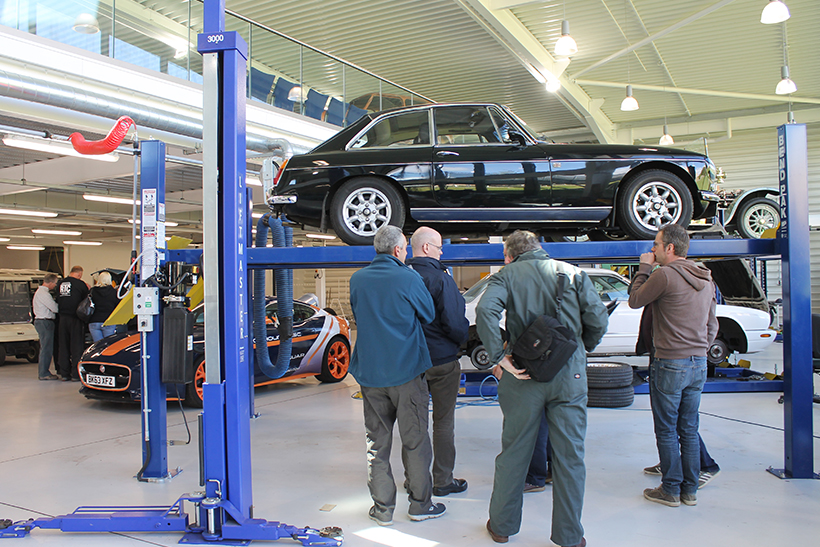April saw the return of the popular Classic Virgins Experience Day at the British Motor Museum in Gaydon, Warwickshire. Classic Worlds Rachel Dyke went along for the day to brush up on her workshop skills.
The Classic Virgins Experience Day: a course designed to encourage and support potential classic vehicle owners – and those who are seriously considering buying one for the first time in the near future.
Aimed at providing its participants with guidance on the theory of classic car ownership (and basic maintenance skills), the two year old course now has the added draw of the British Motor Museum’s state of the art restoration workshop in which to learn the ropes.
A new course, planned for later on this year, will follow on in the evolution of Classic Virgins with a ‘Living With A Classic’ tutorial that will explain how to run a classic vehicle for a year – along with all the challenges to expect when embarking on ownership of your first ever classic.
FIRST THINGS FIRST
The day started with a relaxed discussion in one of the British Motor Museum’s new educational facility classrooms, where Volunteer Course Director Bob Wilkinson introduced the team who would guide us throughout the day. A passionate classic car enthusiast, Bob is patently invested in the future of classic car ownership.
Classic Virgin aims to plant a seed – ensuring the future of the classic car world continues to thrive after our previous generations have been and gone. Acknowledging that it is today’s owners who will ultimately inherit these cars, imparting the skills necessary to keep said classics on the road is, Bob would argue, of utmost importance.
After Bob welcomed us, we were introduced to Claire Serrell, a young classic car hobbyist invested in historic vehicle preservation. A mechanic at Jaguar by trade, Claire works on modern and current Jaguar models by day before returning home in the evening to her beloved classics. She was bitten by the classic bug at a young age; as a 12 year old, she helped her father rebuild a Mini.
Claire led the class with a bright and enlightening presentation about the first steps to take when looking to buy a classic car. Why to buy a classic; the benefits of joining up with car clubs; how to identify a solid project or car to buy; how to rust proof and rectify paint ; storage options and lay-up tips.
Even a new enthusiast with the most basic of vehicle understanding could follow and understand – something which I found to be really refreshing. Put off by their lack of knowledge, many classic first timers worry about getting too deep into such subjects for fear of judgment. Claire allayed my fears: that, she explained, was among the many reasons she volunteered to help with Classic Virgins in the first place.
IN THE METAL
Introductions over, the class was led into the Collections Centre – home to the British Motor Museum’s vast restoration workshop. We were broken off into four groups and toured a series of different vehicles.
Volunteers David Rainbow, Leslie Gunde, Malcolm Graham and Chris Bramley explained a whole range of maintenance subjects, including filter changes, brake fluid checks, ignition and fueling.
The facilities afforded by the Collections Centre meant that vehicles were able to be ramped up safely and securely, allowing participants full access to their undersides – a far cry from the trolley jack and axle stand arrangements forced on many classic car owners.
Seeing cars suspended in the air offered much-needed context for the first timer; to someone that has perhaps never has seen, much less carried out a brake bleeding procedure, Classic Virgin’s ‘access all areas’ approach paid dividends.
It’s one thing to verbally explain something like that, but a whole new ball game to be able to actually see it take place. For me, this particular segment of the day felt like an invaluable lesson – and certainly something an inexperienced new owner would benefit from.
Following lunch, the afternoon welcomed perhaps the most exciting element of the day: the chance to go out for a ride in the stunning Warwickshire countryside in a variety of classic cars.
Guests could choose from 13 different classics; from a diverse line up that included a VW Corrado, a Sunbeam Alpine, a Riley RMA, a Triumph Stag and an Austin Maxi, my personal favourite was a beautiful Jaguar MkII – from which I got some passenger seat time.
We ventured out in convoy to the Tool Connection (Laser Tools) facility at Southam. Offering a range of tools for every conceivable task, Laser sponsors the Classic Virgins program. There was also a mini museum with lots of vintage and classic car memorabilia, models and prototypes on display.
Our visit also offered the chance to speak with technical writer Keith Anderson, who explained the importance of buying good quality tools and equipment when working on classic cars – some of which can be seen in our Products In Brief column opposite.
Vehicles were swapped for the journey back to the British Motor Museum; after my second classic car ride of the day, we finished with a course summary and catch-up with Bob and the volunteers to offer further advice.
The day for me was an absolute joy – a gem for the younger or less-experienced classic enthusiast who may have the interest but not necessarily the knowledge. It proved to be a fascinating and enjoyable insight into the ownership of these vehicles and the people who work to preserve their history, passing their enjoyment and experience of our hobby on to the next generation.


















